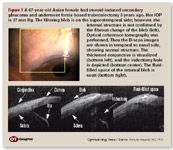Article
Analysis of anterior segment after glaucoma surgery now easier
Keisuke Kawana, MD, PhD, describes a prototype high-speed, swept-source, three-dimensional cornea and anterior segment OCT device (3D CAS-OCT) that was built by the Computational Optics Group at the University of Tsukuba. Dr. Kawana and colleagues used this OCT device to analyze anterior eye segments after glaucoma surgery and obtained clear images following procedures such as trabeculectomy, trabeculotomy, and laser iridotomy.

In his presentation, Dr. Kawana, assistant professor, Department of Ophthalmology, Institute of Clinical Medicine, University of Tsukuba, Japan, described a prototype high-speed, swept-source, three-dimensional cornea and anterior segment OCT device (3D CAS-OCT) that was built by the Computational Optics Group at the University of Tsukuba. Dr. Kawana and colleagues used this OCT device to analyze anterior eye segments after glaucoma surgery and obtained clear images following procedures such as trabeculectomy, trabeculotomy, and laser iridotomy.
The device has high penetration because of its 1.3-µm light source and a high measurement speed of 20,000 A-scans/sec. It also has extensive imaging capabilities. It was designed for analyzing the cornea, anterior chamber, conjunctiva, sclera, iris, angle recess, pars plicata of ciliary body, and the lens. The ciliary processes, however, cannot be imaged because of the wavelength light limitation.
Kinds of images
Dr. Kawana and his colleagues have obtained 3-D images from a series of cases and believe that the 3-D OCT prototype is capable of analyzing every kind of glaucoma surgery, including imaging of the filtering bleb and the trabeculectomy site, and quantitative assessment of the laser iridotomy hole.
Newsletter
Don’t miss out—get Ophthalmology Times updates on the latest clinical advancements and expert interviews, straight to your inbox.




